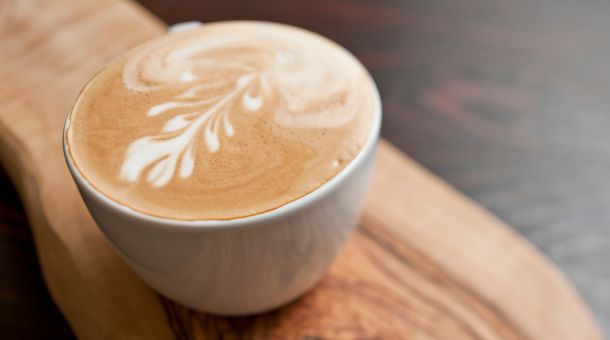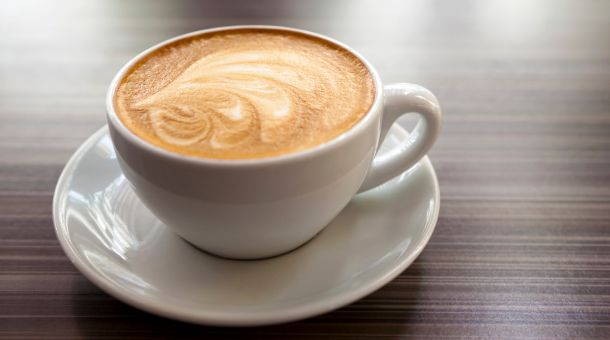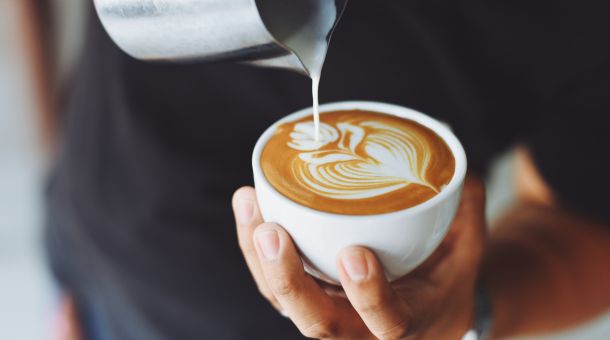“Step into the world of coffee innovation with ‘White Coffee: Unveiling the Unique Brew.’ In this intriguing exploration, we uncover the secrets of a distinct coffee variant that has been gaining popularity for its exceptional flavor and brewing process.
From understanding what white coffee is to discovering its unique taste and brewing techniques, join us on a journey that will leave you with a newfound appreciation for this aromatic gem in the world of coffee.
Whether you’re a seasoned coffee enthusiast or a curious beginner, this article will enlighten you about the subtle nuances and delightful surprises hidden within a cup of white coffee.”
What Is White Coffee?

White coffee is called that because it’s made by roasting coffee beans differently. Instead of roasting them for a long time at a high temperature, white coffee beans are roasted quickly at a lower heat.
This gives them a lighter color and a milder taste. Regular coffee beans are usually dark brown, but white coffee beans are a light yellowish-beige color.
White Coffee vs Black Coffee
| Aspect | White Coffee | Black Coffee |
| Appearance | Pale, creamy color | Dark brown to black |
| Ingredients | Coffee, milk or cream | Coffee, water |
| Flavor | Creamy, sweet, mellow | Bold, robust, bitter |
| Caffeine Content | Generally lower | Generally higher |
| Calories | Higher due to milk or cream | Very low |
| Texture | Smooth and creamy | Thin and watery |
| Popular Variations | Latte, cappuccino, flat white | Espresso, Americano, drip coffee |
| Customization Options | Various flavored syrups, spices | Sugar, milk, cream, syrups |
| Preferred Temperature | Typically served hot or iced | Typically served hot |
| Health Considerations | More calories and sugar | Fewer calories, less sugar |
| Dairy-Free Options | Available with non-dairy milk | Dairy-free options available |
| Common Occasions | Brunch, dessert, social settings | Morning, work, caffeine boost |
What Does White Coffee Taste Like?

The taste of white coffee can vary depending on factors like the bean variety (arabica or robusta) and its origin.
However, what sets white coffee apart is its unique flavor profile, characterized by a light and smooth body.
Unlike traditional coffee, which undergoes a longer roasting process, turning the beans brown and imparting a strong, bitter flavor, white coffee offers a different experience.
White coffee has a distinct sweet and nutty taste with subtle floral undertones. The sweetness is derived from the natural sugars present in lightly roasted beans, while the nuttiness is a result of the oils that are preserved during the gentle roasting process.
This combination makes white coffee an appealing choice for those who prefer a coffee that is less intense and bitter.
Does White Coffee Have More Caffeine?
White coffee typically contains more caffeine than black coffee. The higher caffeine content in white coffee can be attributed to its lighter roasting process.
During roasting, as the beans become darker, some of the natural caffeine content is burned off. In contrast, white coffee’s gentle roasting retains more of the caffeine present in the beans, resulting in a higher caffeine concentration.
It’s important to note that the exact caffeine levels can vary based on factors like bean variety, origin, and brewing method.
Nevertheless, in general, white coffee tends to have a caffeine content that is notably higher than that of fully roasted black coffee. This distinction in caffeine levels is one of the key differences between the two coffee types.
Different Types Of White Coffee

Ipoh White Coffee: A Malaysian Classic
The roots of white coffee can be traced back to the charming town of Ipoh in Malaysia. This original Ipoh white coffee has stood the test of time and remains a beloved choice across the nation.
Its distinct flavor is crafted through a unique process where coffee beans are roasted with margarine, lending a special character to the brew.
Following roasting, the coffee is combined with condensed milk, resulting in a lusciously creamy and sweet coffee.
What sets Ipoh white coffee apart is not just the ingredients but also the meticulous preparation and serving method.
It’s a delightful departure from traditional coffee, and the addition of milk or creamer further enhances its appeal, making it a staple in the world of Malaysian coffee.
Kahwe Bayda: The Lebanese “White Coffee”
Kahwe Bayda is a caffeine-free beverage prepared from a blend of water, orange blossom water, and optionally sweetened to taste.
While it may not be a coffee-based drink, it derives its name from the translation of “Kahwe Bayda” in Lebanon, which means “white coffee.”
This Lebanese “white coffee” is not about caffeine but is renowned for its traditionally believed soothing properties when consumed. It’s a unique and comforting beverage that has its own special place in Lebanese culture.
Kopi Putih: The Indonesian White Coffee
In Indonesia, the term “Kopi Putih” translates to “white coffee,” but it refers to a unique coffee bean roasting process.
Kopi Putih involves roasting the beans for a shorter duration and at lower temperatures compared to regular coffee beans.
This lighter roasting method produces coffee beans with a pale color, often referred to as “Biji Kopi Putih” or white coffee beans.
These white coffee beans have distinct characteristics, being harder and offering a different taste profile than their fully roasted counterparts.
The light roast prevents the beans from developing the typical strong coffee flavor. Importantly, due to the shorter roasting duration, white coffee tends to have a higher caffeine concentration.
White Coffee: A Unique Coffee Experience
White coffee is a coffee beverage that has been gaining popularity in recent times. It offers an alternative to the traditional black coffee.
Whether you prefer the bold, strong, and intense flavor of black coffee or opt for the lighter, bittersweet notes of white coffee, it provides a versatile and appealing choice for coffee enthusiasts.
The growing popularity of white coffee reflects the diversity of coffee preferences and the enjoyment of its distinct taste.
Benefits of white coffee
- Milder Flavor: White coffee’s lighter roast results in a smoother and less bitter taste, making it more approachable for those who find black coffee too strong.
- Higher Caffeine Content: The shorter roasting process preserves more caffeine, providing a stronger caffeine kick for those seeking an energy boost.
- Less Acidity: White coffee is often less acidic, making it gentler on the stomach and potentially more suitable for individuals with acid sensitivity.
- Customization: It’s versatile and can be customized with various sweeteners, milk, or non-dairy alternatives to suit individual taste preferences.
- Unique Aroma: The lighter roasting process preserves different aromatic compounds, giving white coffee a distinctive aroma and flavor profile.
- Variety of Recipes: White coffee can be
Brewing Tips for the Perfect Cup of White Coffee
Brewing white coffee requires a slightly different approach than regular coffee due to its lighter roast and unique flavor profile. Here’s how you can make the most of your white coffee beans:
1. Choose Quality Beans: Start with high-quality white coffee beans. Look for beans that are freshly roasted and preferably sourced from a reputable roaster. The quality of the beans significantly impacts the final taste of your coffee.
2. Grind Size: You will find many white coffees sold are already pre-ground because this is an important factor. But, if you need to grind your white coffee beans, opt for a medium grind to ensure an even extraction of flavors. The grind size should be similar to that of table salt.
3. Water Temperature: Keep the water temperature slightly lower, around 190°F (88°C), to prevent scorching the beans and preserving their delicate flavors.
4. Brewing Methods: White coffee can be brewed using various methods, including pour-overs or drip coffee makers. Experiment with different techniques to find the one that brings out the best in your beans.
5. Experiment: Don’t be afraid to experiment with brew times and ratios. Since white coffee beans vary in flavor, finding the right balance is key to enjoying your cup.
FAQ
Is white coffee the same as a latte or cappuccino?
No, white coffee is not the same as a latte or cappuccino. While those are espresso-based drinks with milk, white coffee is brewed using underroasted beans, and it doesn’t necessarily contain milk.
How is white coffee brewed?
White coffee is brewed by using lightly roasted coffee beans. The beans are ground and brewed like regular coffee but with a shorter brewing time and often using a French press or a pour-over method.
Can I make white coffee at home?
Yes, you can make white coffee at home by purchasing lightly roasted coffee beans and following specific brewing instructions to achieve the desired flavor profile.
Where can I find white coffee?
White coffee may be available at specialty coffee shops, but it can also be ordered online from coffee bean suppliers and specialty stores.
Is white coffee more caffeinated than regular coffee?
Yes, white coffee tends to have a higher caffeine content compared to traditionally roasted coffee due to the underroasting of the beans. This makes it a good choice for those seeking a strong caffeine kick.
Are there any variations of white coffee from different regions?
Yes, various regions may have their own variations of white coffee, each with unique characteristics and flavor profiles. Exploring these regional differences can be an exciting coffee adventure.
Conclusion
White coffee stands as a unique and intriguing addition to the world of coffee. Its light roasting process results in a coffee with a distinct flavor profile, making it an appealing option for those seeking a milder and less acidic brew.
Whether you’re a coffee connoisseur or just someone looking to expand their coffee horizons, white coffee offers a fascinating journey through the diverse and delicious world of coffee. So, why not give it a try and savor the subtle, yet delightful, nuances it brings to your cup?”

